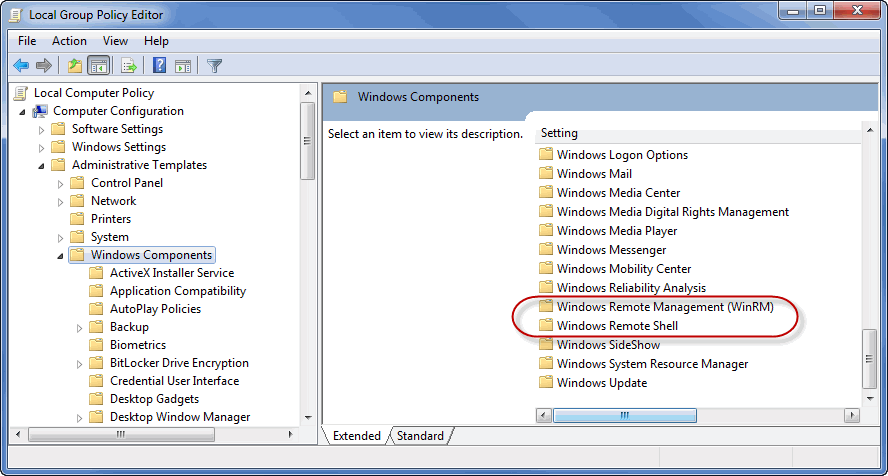Configuring the Agent Manager (monitoring) system
If the Agent Manager fails to find a configuration file, it attempts to automatically detect the required settings and writes them to $FGLAM/state/default/config/krb5.conf.
You can manually override the location of krb5.conf with the following command-line parameter:
-Djava.security.krb5.conf=</path/to/file>
Generating a configuration file required for WinRM Negotiate authentication
WinRM connections using the default Negotiate authentication require a copy of the krb5.config file. On Windows®, the Agent Manager attempts to auto-generate this file and places it under <fglam_home>f/state/default/config/krb5.config. Under some circumstances, the Agent Manager is unable to auto-generate the file on Windows, in which case the file needs to be created. On UNIX® systems, the file is never auto-generated and must always be provided.
If the file needs to be created, the format of the krb5.config file for the WinRM Negotiate authentication is as follows:
The values dns_suffix_upper_case, dns_suffix_lower_case, and DNS_Server_for_dns_suffix_upper_case must be replaced with their actual values.
The [domain_realm] section in the file maps the domain of the host being connected to, to a realm.
The [realm] section provides the relevant kdc (key distribution center) server with a specific realm to use for kerberos authentication. This is generally the DNS server for the relevant domain.
The default_realm value in the libdefaults section is the realm mapping to use when the domain of the host cannot be matched to a realm.
For example, for connecting to hosts on the sample.domain.com domain with the dnsserver.sample.domain.com DNS Server, the contents of the krb5.config file should be as follows:
When connecting to a host1.sample.domain.com, the host1’s domain is mapped to the SAMPLE.DOMAIN.COM realm, which maps to the DNSSERVER.SAMPLE.DOMAIN.COM kdc to use for kerberos authentication.
After the krb5.config file is created the absolute path to the generated krb5.config file should be provided in the <config:krb5-config-file> tag value of the <fglam_home>/state/default/config/fglam-config.xml file, so that it can be accessed by the Agent Manager. Any changes to the fglam-config.xml file require the Agent Manager to be restarted in order for those changes to take effect. Therefore, if the Agent Manager is running while you are making these changes, you must restart it.
|
• |
By default, Windows does not allow JavaTM to access certain required session keys when JavaTM attempts to authenticate with Kerberos. The following registry keys should be added to ensure that the required sessions keys are available. The Agent Manager attempts to detect and update these registry keys automatically the first time a WinRM connection is attempted. |
|
• |
Key: HKEY_LOCAL_MACHINE\System\CurrentControlSet\Control\Lsa\Kerberos\Parameters |
|
• |
Value Name: allowtgtsessionkey |
|
• |
Value Type: REG_DWORD |
|
• |
Value: 0x01 |
|
• |
Key: HKEY_LOCAL_MACHINE\System\CurrentControlSet\Control\Lsa\Kerberos |
|
• |
Value Name: allowtgtsessionkey |
|
• |
Value Type: REG_DWORD |
|
• |
Value: 0x01 |
The KerberosConfigurationService API provides the ability for agents to modify or create a Kerberos configuration file during runtime.
The Agent Manager uses the Kerberos configuration file to establish WinRM Negotiate connections to hosts. In most cases, the Agent Manager can create the Kerberos configuration for the current domain to which the machine running the Agent Manager belongs. However, the Kerberos configuration typically needs to be modified when cross-domain WinRM connections are required. This can be done by modifying the Kerberos configuration file manually, to add the new domain properties, and restarting the Agent Manager. If no instance of the previous Kerberos configuration file is found, the fglam.config.xml file needs to be updated to instruct the Agent Manger which Kerberos configuration file to use for WinRM connections.
All of these actions can also be performed during runtime, without requiring any manual changes, or an Agent Manager restart. The KerberosConfigurationService allows agents to make these changes during runtime and have the changes take effect immediately. If a new configuration file is created, fglam.config.xml file is updated automatically.
Configuring command-shell connection settings
|
• |
MaxConcurrentOperationsPerUser: This parameter specifies the maximum number of concurrent Enumeration operations allowed by an individual user. The value must be in the range of 1 to 4294967295. |
|
TIP: WinRM parameters can also be edited using the Group Policy Object Editor. To start the editor, type gpedit.msc at the command line, and then navigate to Local Computer Policy > Computer Configuration > Administrative templates > Windows Components > Windows Remote Management (WinRM) and Windows Remote Shell. |
|
• |
MaxConcurrentOperations: This parameter specifies the maximum number of concurrent Enumeration operations allowed by an individual user. Any number from 1 to 4294967295 can be used. For more information about this parameter, you can visit the following Web page: http://msdn.microsoft.com/en-us/library/cc251426.aspx. |
|
• |
MaxShellsPerUser: This parameter specifies the maximum number of concurrent shells any user can remotely open on the same system. Any number from 0 to 2147483647 can be used, where 0 means unlimited number of shells. If this policy setting is enabled, the user cannot to open new remote shells if the count exceeds the specified limit. |
|
• |
AllowRemoteShellAccess: This parameter controls access to the remote shell. It must be set to true. |
For additional information, visit the following Web page:
http://msdn.microsoft.com/en-us/library/windows/desktop/aa384372%28v=vs.85%29.aspx
About WinRM connection ports
|
• |
WinRM 1.1 and earlier: The default HTTP port is 80, and the default HTTPS port is 443. |
|
• |
WinRM 2.0 and later: The default HTTP port is 5985, and the default HTTPS port is 5986. |
After issuing the winrm quickconfig command, the listener port number can be determined using the winrm enum winrm/config/listener command. For example:

